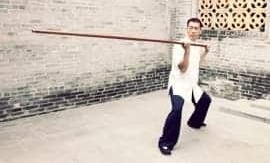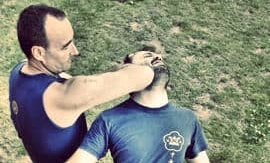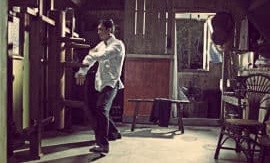
FOR THOSE OF YOU WHO DON’T KNOW ME, I AM FROM ENGLAND AND THE WORLD’S FIRST NON-ASIAN, HONG KONG TRAINED MASTER OF WING CHUN GUNG FU. I WAS CERTIFIED TO TEACH THE ART BY KOO SANG SIFU IN 1975.
I began my martial arts training in Wado Ryu Karate in the early 1960s under Sensei Danny Chaganis in the little seaside town of South Shields, in the North East of England—the town from which famed moviemakers, Tony and Ridley Scott, hail.
I later studied Wing Chun under Sifu Paul Lam in London. Paul was the first Chinese master to teach Wing Chun to foreigners in the UK. He was held in high esteem by the local Chinese community there, as a teacher and a businessman.
After Paul closed his school to focus on other business opportunities, I trained with Sifu Joseph Cheng in London. Joe and I became like brothers and, like Paul, Joseph taught his classes in Chinatown. However, when he closed his school to become the personal bodyguard to a Saudi Prince, I realised the only way I could get certified to teach Wing Chun was to move to Hong Kong and study with the Chinese masters there.
I wrote to the Hong Kong Martial Arts Association, and they recommended I study with Koo Sang. They passed my letter on to him, and Koo Sang agreed he would consider taking me on as a student. This was a very big deal for me, as traditionally, teachers in Hong Kong refused to teach Gwailo (or “Foreign Devils”).
When I arrived at the airport in Hong Kong, one of Koo Sang’s students picked me up and took me directly to Koo Sang’s gym on Shanghai Street, where I was introduced to Koo Sang. Physically, he was fairly tall and wiry, but well-proportioned. He was friendly and shook my hand. After formal introductions, we all went across the street to the local restaurant, where a student explained we would go back to Koo Sang’s gym after eating. He then handed me a red envelope and explained that Koo Sang would leave his jacket on the back of a chair and go into the next room. I was to put some “Lucky Money” into the red envelope and, depending on how generous I was, he would then decide whether to take me as a student. Obviously, I was generous enough, as he took me as a student and told me to come back early the following morning.
The next day, when I arrived for my first class, there were a lot of young guys and high school kids practising in the morning class. Some were shocked, and others were amused to see a Gwailo participating in their class. But mostly, everyone was friendly and wanted to know who I was.
For the first session, Koo Sang gave me the grand tour of his gym. Since he was a carpenter, he had built a lot of specialised training equipment. There were rows of wall-bags near the entrance, and each bag got progressively harder to work on as you moved down the line. You were expected to do a couple hundred punches on each bag and then rub Dit Da or Chinese medicine into your knuckles as they became bruised. This was just a warm-up before the class began. Then there was a series of Wooden Kicking Posts he had built for specialised Wing Chun kicking techniques. After that, there was a wall-mounted Wooden Dummy, a Long Pole Dummy and a Baat Jaam Do Dummy.
Rounding off the equipment section was a series of heavy bags, including a sausage-shaped bag he had built specifically for Wing Chun centreline punching. For the evening sessions, he would take down the heavy bags to make enough space for the students to practise their Chi Sau and Wing Chun forms. He also had wall-mounted racks, like a billiard parlour, for holding the long poles and training poles of varying lengths and thicknesses.
To end my morning training session, he taught me his version of the Siu Lum Tau, which was a lot different from the way I had learned it in London. Then, when he gave the formal salute to end the morning class, he went back into his private room. Meantime, the students were running around like hornets, frantically trying to get out of there ASAP! Kenny, one of the high school students, ran out of the door laughing as he was pulling on his sweater, almost tripping up as he ran. He looked back at me saying, “You don’t know the rules yet! Last person out has to take Sifu for lunch!” Koo Sang popped his head around the door of his room and said, “Alan?” Actually, it was okay by me. We went to the local restaurant, where I picked up the bill.
Normally, the Chinese would charge foreigners double. However, when I went in with Koo Sang, they charged me the regular price. So it was the same price for me, whether or not I took Koo Sang with me. It soon became a regular thing for me to take him for lunch every day after our morning sessions, and I got to know Sifu well after doing that.
Koo Sang loved the social interaction of eating out. The inside of the restaurant we went to was like a zoo, with people feeding birds and animals on their tables as they ate. Koo Sang was well liked there, and he had one good friend, a Tai Chi master, who loved to spar with me; he would launch a series of attacks at me as we walked into the restaurant! When I counter-attacked, he would squat down, scurry backwards, and hide under a four-legged stool by the entrance that was only three feet off the ground. He could fit under it, while still in his boxing poses! Talk about flexibility! Koo Sang would laugh at all this commotion and then order his favourite dish of Char Siu (roast pork). Not exactly the food of champions, but he loved it.
After eating, I would spend the rest of the day exploring Hong Kong and get back in time for the afternoon and evening classes. After the evening class, Koo Sang would give me my private session before I would turn in. I stayed in a room attached to Koo Sang’s gym for a few months before I found my own place.
I will always remember the day Koo Sang was preparing the room for me. In the middle of his gym was a beautiful table he had built.I said to his students, “That’s a really nice table Sifu built.” They told him, and they all fell down laughing. They interpreted as he spoke, “That’s not a table; it’s your bed!” That’s when I found out the Chinese like to sleep on a hard surface. However, he gave me a bedroll and a regular pillow, though, so that was somewhat of a break.
Koo Sang was best known in the Wing Chun community for his Wooden Dummies. Everyone in the Wing Chun Clan wanted to own a Koo Sang Jong. Sifu built his dummies entirely by hand, and I used to watch in amazement as he was constructing them. Often, he would customise a dummy to suit the height and weight of the practitioner. He would start with an eight-sided piece of teakwood for the trunk. Sifu would buy a square block of teakwood from a local vendor, who would cut it to the appropriate length. He then carried it on his shoulder to the shop of a friend who owned a bench saw. His friend would then cut the block into an eight-sided piece. Koo Sang would then carry it to his gym and make it perfectly round by using an electric hand sander. He made the holes for the arms and the leg by using a hammer and chisel. He took many hours and a lot of elbow grease to make one, but they all turned out beautifully.
And being a master carpenter, Sifu was also a fine artist. He loved to paint using Chinese watercolours. When he was not making Wooden Dummies, he would relax with a steaming hot cup of tea in one hand and a paintbrush in the other, standing in front of a giant easel, with a full-sized painting in progress displayed on it. He really was a multi-talented individual.
Koo Sang took his Wing Chun training seriously. He seldom laughed during our classes, unless he was the one telling the jokes—then he could laugh heartily. Sifu was a good guy and a straight shooter. He always made direct eye contact when he spoke to you, and he could be very intense. However, his touch in Chi Sau was light, compared to some teachers I had worked with in the past. His execution of techniques during Chi Sau practice was always quick, precise, and accurate, with a good sense of flow and sensitivity. His weapons’ techniques were superb, and he was held in high esteem by many of his contemporaries in Hong Kong.
Koo Sang was a consummate martial artist. As a teacher, he was somewhat of a perfectionist. He would put the time in with you until you got what he was trying to convey to you. I was constantly reminded by all of the masters I met from Ip Man’s school how fortunate I was to have someone who was so well-respected in the Wing Chun community as Koo Sang Sifu, to be my teacher. But I didn’t need reminding! I knew how fortunate I was to be his student, and I will always be grateful I could spend the time I did with Koo Sang. I thank him (now in spirit) for the generosity he showed in accepting me as his private student and for sharing with me the art of Wing Chun Gung Fu.



















